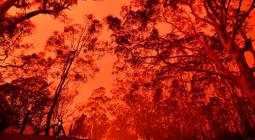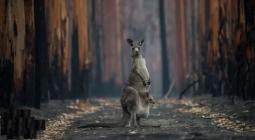Indigenous cultural burning managed Australia’s bushfires long before colonisation. It’s needed now more than ever, a study says
As wildfires become more frequent and intense due to the climate crisis, combining the First Nations practice with western techniques is ‘crucial’
Indigenous cultural burning practices halved the shrub cover across south-east Australia thousands of years before colonisation, reducing the intensity of bushfires, new research suggests.
The study’s authors argue that “wide-scale re-integration” of cultural burning practices, in combination with western fire management techniques, is “crucial” at a time when wildfires are becoming more frequent and intense due to the climate crisis.
The study, published in the journal Science, found that shrub cover in south-east Australia since European colonisation has increased to the highest levels ever on record, increasing the risk of high-intensity fires.
Indigenous cultural burning practices involve systematically applying frequent low-intensity fire to the land. They differ from the hazard reduction burning used by fire authorities, which can be more intensive and extensive.
The study found that during the early to mid-Holocene period, 6,000 to 12,000 years ago, the shrub layer in woodlands and forests accounted for about 30% of land cover. Indigenous cultural burning halved shrub cover to 15% about 6,000 years later. Since European colonisation, that figure has increased to 35%, the researchers found.
A study co-author, Dr Simon Connor, of the Australian National University, said the reduction in the shrub layer made it more difficult for ground fires to travel upwards into the forest canopy and create high-intensity fires.
“Once Europeans come in and Indigenous populations are displaced from their land, then fires come back in a big way – the shrub layer comes back in an unprecedented way,” Connor said. “The pace of change in the last couple of hundreds years has been so fast compared to what’s happened over thousands of years.”
The study’s findings pointed to “a way that fire can be used to fight fire”, Connor said. He emphasised that cultural burning involved an intimate understanding of vegetation in different ecosystems and could involve “not burning a particular vegetation type”.
“Many Indigenous communities are really keen to reintroduce or reinvigorate cultural burning,” Connor said. “But when they try to do it, they hit … layers of bureaucracy that prevent that cultural practice being carried out.”
Prof David Lindenmayer, a forest ecologist also at ANU, who was not involved in the research, said there was no doubt that cultural burning was very important in certain areas.
While extensive burning occurred, he said, particularly in grasslands and woodlands in inland Australia, there were other areas where First Nations people deliberately avoided using fire.
Lindenmayer’s research has previously found, for example, that cultural burning was not widely practised in the mountain ash forests in Victoria.
“There are pretty significant parts of some forest landscapes that have no history of extensive burning – some of the tall wet forests, the Gondwana rainforests, tropical rainforests,” Lindenmayer said. “This is a very complicated area, because what is appropriate fire in some cases is actually highly inappropriate fire in others.”
The researchers used pollen counts to estimate shrub cover at different periods, and calculated historical burning through charcoal in sedimentary records. In total, they analysed 2,833 archaeological records on vegetation cover, past climate, burning and population size.
The study’s lead author was Dr Michela Mariani, an associate professor at the University of Nottingham.
Cover photo: Once Europeans come in and Indigenous populations are displaced from their land, then fires come back in a big way,’ study co-author Dr Simon Connor said. Photograph: Adam Ballard/DFES





